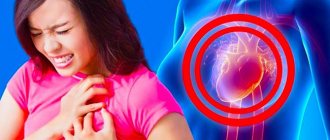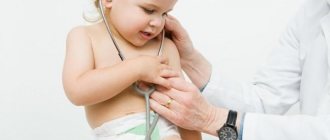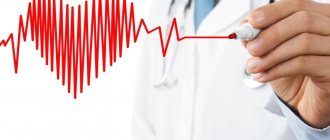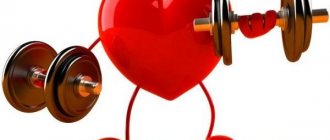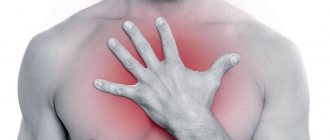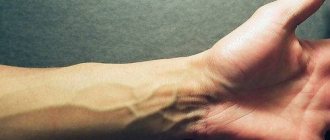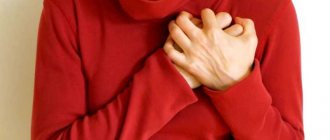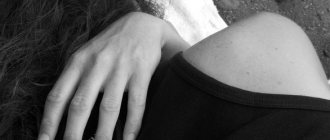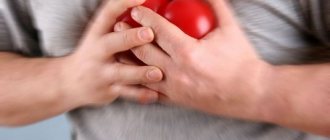Causes of heart pain after eating
There are a huge number of factors that can cause unpleasant pressure and pain in the heart after eating.
Gastritis
Gastritis is an inflammatory process that affects the cavity of the gastric mucosa, leading to a malfunction of its functioning.
One of the root causes of the disease is the formation of antibodies to the stomach’s own cells. Sometimes pathology occurs against the background of:
- non-compliance with dietary nutrition;
- alcohol abuse;
- smoking cigarettes;
- failure of the normal regulation of the human nervous system.
Gastritis
Gastritis in chronic form does not imply the presence of certain symptoms outside the period of exacerbation. And depending on what type of gastritis manifests itself, in the absence of a diet menu, pain appears immediately or within half an hour after eating.
Of course yes. After all, a mandatory manifestation of this pathological disease is an ulcerative defect in the stomach cavity.
And depending on the location of the ulcer, exacerbation attacks may be accompanied by:
- pain in the heart area after eating half an hour or an hour after eating. There may be hunger pains that occur at night.
- dispersion phenomena;
- such attacks can worsen during certain seasons of the year, for example: in autumn or spring.
The pain syndrome does not disappear after:
- use of antacids and antisecretory drugs;
- applying a hot heating pad to the location of the pain.
Binge eating
Constant overeating leads to indigestion, which becomes an active provocateur of pain in the sternum. There is increased gas production and a feeling of heaviness after eating. Although fatigue after eating can become a response (reaction) to foods, for example: sweets or flour products. Discomfort may occur from garlic. It all depends on the individual characteristics of the body.
angina pectoris; myocardial infarction; pericarditis. aortic dissection; pulmonary embolism; pulmonary hypertension.
pleurisy; pneumonia; tracheobronchitis; spontaneous pneumothorax. esophageal reflux; stomach ulcer; gastritis; pancreatitis. costochondritis; cervical disc disease; injury. Herpes zoster. panic disorders.
Let's discuss in more detail some of the reasons why your heart hurts after eating.
What to do if your heart hurts after drinking alcohol, read this
article
Gastritis
Inflammation of the mucous membrane of the stomach wall, which leads to some dysfunction.
One of the pathogenesis of gastritis is the formation of antibodies to one’s own cells of the gastric mucosa.
diet violation; excessive alcohol consumption; smoking; presence of duodenogastric reflux; disorder of regulation of the body's humoral and nervous systems.
Chronic gastritis does not have clear symptoms outside the period of exacerbation. Depending on the type of gastritis, if the diet is not followed, pain in the heart after eating occurs immediately or after half an hour.
persistent heartburn, belching (sometimes with the smell of rotten eggs), vomiting (vomitus) with food particles, bloating, rumbling.
Characterized by unstable stools with a tendency to diarrhea.
Stomach ulcer
This is a long-term recurrent disease, which occurs with alternating periods of exacerbations and remissions, while an obligatory component is the appearance of an ulcer in the wall of the stomach.
The pathogenesis of peptic ulcers comes down to an imbalance between the factors of aggression of the succus gastricus (stomach juice) and the mechanisms of protection of the gastric mucosa.
The main symptom is pain.
pain in the heart after eating, they can appear within 30 minutes - 1 hour after eating, the appearance of hunger pain and night pain is possible; dyspepsia may occur; often have a certain seasonality (spring, autumn).
taking antacids, taking antisecretory medications; using a heating pad.
Esophageal hernia
Pain in the epigastrium, intensifying after eating and in a lying position, or with a sudden change in body posture.
nausea; heartburn.
after eating there is pain in the heart area; episodes of bradycardia or tachycardia; dizziness, fainting, collapse.
For many, the symptom manifests itself immediately after eating or at night, in a horizontal position.
Its appearance is associated with the tension of the branches of the nervus vagus when the stomach is perforated through the opening of the hernia.
Pancreatitis
The pathogenesis is based on a violation of the outflow of pancreatic secretions due to blockage of the Wirsung canal.
sudden unbearable pain in the area of the xiphoid process and in the chest, especially if it is fatty, fried foods or after excessive consumption of alcohol; occurring 3–4 hours after eating.
the pain is not severe; has a girdling character; radiates to the lower back, left shoulder blade, and rarely to the chest area.
nausea; painful vomiting; salivation; bowel dysfunction, mainly constipation.
Does not completely disappear after taking antacids or eating. Sometimes you need to take antispasmodics and strong analgesics.
pain is continuous or paroxysmal; occurring in the upper abdomen or epigastrium.
The possibility of girdling pain and its irradiation to the left, left shoulder, scapula or area of the left ilium is not excluded.
loss of appetite; hostility, even aversion to fatty and fried foods; nausea; bloating; characterized by the presence of mushy, grayish, foul-smelling “fatty” feces - steatorrhea; weight loss.
Gastritis
Gastritis is an inflammatory process that affects the cavity of the gastric mucosa, leading to a malfunction of its functioning.
non-compliance with dietary nutrition; alcohol abuse; smoking cigarettes; failure of the normal regulation of the human nervous system.
After eating or already in the process of eating, the heart begins to work more actively. Scientists call this phenomenon gastrocardial syndrome. If such an increase is caused by overeating, then the body’s reaction is considered completely natural.
It is worth understanding that tachycardia in this case is not a pathological process, but a symptom. It differs from normal heartbeat by rapidity, i.e. exceeding 90 beats per minute. Elderly people are more likely to experience this pathology than young people, in whom such a symptom may arise due to bad habits, malfunctions of the endocrine system and vegetative-vascular dystonia.
https://www.youtube.com/watch?v=zQMTNUExdQM
There are many other reasons that provoke rapid heartbeat after eating:
- Diseases of the heart and blood vessels - most often they are inflammatory in nature. For example, ischemia or hypertension, which are accompanied by high blood pressure. Also, the frequency of contractions may increase due to myocardial infarction, which is characterized by the death of heart tissue, which increases the load on the heart.
- Fatty deposits can accumulate not only in visible places, but also on internal organs, causing various dysfunctions. When you overeat, the diaphragm begins to rise, causing shortness of breath and increased stress on the heart. Obesity and tachycardia are also associated with each other by increasing energy costs for the digestive process. Thus, if a person has fat deposits, the blood pumping process slows down.
- People undergoing gastric resection often suffer from dumping syndrome. It is characterized by tachycardia, a feeling of fatigue and increased sweating. Symptoms usually increase after eating, because food enters the intestines very quickly, which causes additional stress on the body.
- Some diseases in the gastrointestinal tract, without following a diet and proper treatment, worsen over time, which provokes a rapid heartbeat after eating.
- Malfunctions of the thyroid gland similarly provoke increased heart rate after exercise and after eating. This symptom is formed due to the action of the inflammatory process in the body and the formation of hormonal nodes, which lead to disruptions in the endocrine system.
- In diabetes mellitus, an increase in the pulse rate indicates a moment of decompensation, which is manifested in the body by severe disruptions, which are characterized by a persistent increase in sugar levels.
- Some neurotic conditions may manifest as tachycardia immediately after eating. Relieve such symptoms, perhaps by resting a little or taking a sedative as prescribed by your doctor. After the psycho-emotional background is normalized, the tachycardia will disappear on its own.
- Some medications can cause heart palpitations after eating, especially if they were taken 10-15 minutes before eating. Doctors associate this complication with the formation of side effects to medications.
- insufficient nutrition of the heart muscles themselves;
- inflammatory process in organ tissues;
- metabolic disorders in the coronary arteries;
- a large load that causes changes in the organ itself (enlargement of the ventricles, loose closure of the valves).
2. Diseases that do not directly concern the heart, but radiate pain to this area:
- gastrointestinal pathologies (gastritis, ulcer);
- neuralgia – clamping of nerve endings in the spinal column, ribs;
- pathologies of the lungs and bronchi;
- consequence of injury.
Myocardial infarction is ischemic necrosis of heart tissue:
- during the process (during an attack), necrotic areas appear on the myocardium, a sudden sharp pain appears, radiating to the left arm and back;
- there is numbness in the limb;
- with a small area of necrosis, the patient feels a burning sensation and compression in the sternum, but can stand on his feet.
Why does it hurt?
Various pathologies of the heart muscle can lead to unpleasant or painful sensations. What makes the heart hurt can only be said for sure after diagnosis. Among the probable reasons:
- coronary heart disease (angina pectoris, myocardial infarction, cardiosclerosis);
- inflammatory diseases (pericarditis, endocarditis, myocarditis);
- congenital defects (pulmonary artery stenosis, septal defects, Ebstein's anomaly, etc.);
- acquired defects (mitral valve stenosis, pulmonary valve stenosis, etc.);
- aortic aneurysm (dissection).
In some cases, one of the reasons why pain in the heart area may be osteochondrosis. It is possible to distinguish the disease based on certain signs:
- Pain is felt in a specific area related to the affected area.
- There may be numbness, burning, or tingling in the same area.
- Localized increased sweating, pallor or redness of the skin may occur.
- In some cases, the pain spreads to the limbs, to the shoulder blades, neck area, etc.
Many people, experiencing pain in the heart area, immediately turn to a cardiologist. Fortunately, in the majority of cases the cause is not cardiac in nature. Thus, intercostal neuralgia can lead to sensations. You can distinguish it by:
- Like. The pain has a stabbing, cutting, piercing, encircling form.
- Localization of sensations. Most often they appear between the fifth and ninth ribs, in the solar plexus area.
- Increased sensations. With intercostal neuralgia, sensations become aggravated after a change in body position, sudden movement, strong laughter, coughing or sneezing.
- The sensations do not stop after taking nitroglycerin.
- The condition may occur due to hypothermia.
- Prolonged manifestation of pain. The attack significantly exceeds the duration of an angina attack.
At night, sensations in the heart area can be caused by:
- diseases of the respiratory system (pleurisy, pneumonia, etc.);
- peptic ulcer;
- intercostal neuralgia;
- joint pathologies, etc.
In some cases, the pain is actually cardiac in nature. Manifestations can be caused by a special form of coronary artery disease - nocturnal angina. Another provoking factor is the narrowing of the lumen of the coronary arteries - coronary spasm.
Mostly such manifestations are not associated with pathologies of the heart muscle. Most often this leads to:
- traumatic effects on the chest;
- pathologies of the respiratory system;
- diseases of bones and joints;
- diseases of the gastrointestinal tract;
- malignant and benign formations;
- intercostal neuralgia, etc.
If your heart hurts when you inhale, the reasons related specifically to the organ itself may be the following:
- cardiac ischemia;
- inflammation of the heart sac (pericardium);
- heart rhythm disturbances, etc.
In some cases, without additional examination, it is not immediately possible to differentiate the cause.
If after physical activity there are unpleasant sensations in the heart muscle, then it is necessary:
- Reduce or completely stop the load until the reasons that led to such manifestations are clarified.
- Pay attention to what types of workouts lead to heart pain. Exclude them from the program.
- Do not increase the load suddenly and without preparation. Increasing the pace of training should occur smoothly.
Running is a cardio load for the body, therefore, it requires increased blood supply to the heart muscle. The following can lead to pain during or after running:
- coronary spasms (stenosis);
- atherosclerosis of coronary vessels;
- dystrophic changes in the heart;
- cardiac ischemia.
Non-cardiac causes are also a factor in causing discomfort or pain when running.
If your heart hurts after eating, this may indicate serious problems in the body. As a rule, sensations are associated with pathologies and diseases of the gastrointestinal tract. For example:
- peptic ulcer;
- gastritis;
- hiatal hernia;
- pancreatitis.
Trauma, mechanical stress, and pathologies of the respiratory system can also be negative factors. Cardiac factors include:
- pericarditis;
- myocarditis;
- endocarditis;
- coronary heart disease, etc.
According to researchers, coffee in small quantities is not capable of affecting organs. However, excessive consumption of an invigorating drink can lead to disruption of the body's functioning. Coffee does not lower blood pressure, which makes it dangerous for people suffering from arterial hypertension.
In addition, the drink helps remove from the body a number of minerals necessary for the normal functioning of the heart muscle. The consequences of such exposure can lead to unpleasant sensations. Coffee can lead to the development of gastrointestinal diseases, which sometimes leads to pain in the heart area.
Most often, this condition is not associated with organ pathologies, but is caused by an adaptation process. The female body undergoes hormonal changes in order to create optimal conditions for the growth and development of the fetus.
In addition, pain during pregnancy can be caused by:
- changes in the tone of the autonomic nervous system;
- intercostal neuralgia;
- anemia;
- gestosis;
- cardiomyopathy, etc.
Pain in an organ or area can be caused by:
- diseases of joints and bones;
- pathologies of the gastrointestinal tract;
- kidney disorders;
- injury received;
- neuralgia;
- heart disease;
- inflammatory disease, etc.
The child usually cannot show where the heart hurts (photos of a person can help parents find out the location of the sensations). The reason most often has nothing to do with the cardiovascular system, but is a reason for an urgent visit to a specialist.
Puberty is accompanied by hormonal changes and rapid growth. It is at this time that a teenager may begin to complain that his heart hurts. This may be due to:
- vegetative-vascular dystonia;
- rheumatism;
- myocarditis;
- psycho-emotional stress.
Vegetative-vascular dystonia is a special form of nervous system disorder, manifested in the form of various symptoms. One of them is pain in the heart.
Typically, these feelings:
- are of a long-lasting nature;
- associated with psycho-emotional stress;
- not associated with physical activity;
- stop after taking sedatives.
Treatment of vegetative-vascular dystonia is carried out comprehensively. It is recommended to visit a psychologist, adjust your daily routine and adhere to the principles of a balanced diet.
Excitement and stress can trigger mechanisms that lead to heart pain. Exactly:
- Spasmodic reaction of blood vessels. Stenosis of arteries and veins, leading to myocardial ischemia or angina. The condition develops as a result of a pronounced reaction of the adaptation system.
- Cardioneurosis. Soreness of the heart muscle caused by psychological or mental factors.
Alcoholic drinks have a toxic effect on the entire body as a whole. The heart also suffers from their use. Long-term consumption of alcoholic beverages leads to the following changes in the organ:
- Development of fatty degeneration. Characterized by excessive accumulation of fat cells in the tissues of the heart muscle.
- Dilation. This is a stretching of the cavities of the organ, leading to disruption of its functioning.
- Hypertrophy. Excessive development and thickening of cardiac tissue.
People who drink alcohol regularly over a long period develop alcoholic cardiomyopathy.
After a stormy evening, your heart hurts for a number of reasons. Most often in connection with:
- with coronary artery stenosis associated with the end of the vasodilator effect of alcohol;
- toxic effects of acetaldehyde;
- arrhythmia, which often occurs against the background of angina pectoris.
The sensation can occur both in people who regularly drink alcohol and in those who rarely allow themselves strong drinks.
Unpleasant sensations in the left half of the sternum can be the result of a variety of diseases. Manifestations are recorded in people of any age, have different forms and duration. At the first such manifestations, you should consult a specialist. An experienced doctor, based on a description of the nature of the pain, in many cases will be able to make a preliminary diagnosis.
Quite often, many people with chest pain do not pay attention to their nature and therefore mistakenly believe that the discomfort is associated specifically with heart disease. The characteristics of chest pain directly depend on the cause and degree of progression of the disease.
For example, often the cause of a burning sensation in the chest is simple heartburn. The reason is that gastric juice enters the esophagus. These pains are often accompanied by belching and a sour taste in the mouth. With heartburn, the unpleasant sensations are clearly associated with food intake, i.e. occur after eating.
Often occur when bending over or when the body is in a horizontal position. Taking antacids relieves the burning sensation in the chest. Absolutely similar discomfort is possible with a disease such as GERD (gastroesophageal reflux disease). One of its manifestations is heartburn.
Pain and heartburn can be caused by a disease such as esophageal spasm. When it occurs, swallowing is impaired due to the fact that the bolus of food does not move correctly towards the stomach. This is due to uncoordinated work of the esophageal muscles. Another pathology is achalasia. The disease is a malfunction of the valve between the esophagus and stomach. In this condition, food lingers in the lumen of the organ for some time, causing discomfort and pain in the chest.
Can your heart hurt after eating?
Have you ever thought at least once about the question of why your heart hurts after eating and what it is? The heart is a hollow organ made of fibrous and muscular tissue that takes blood from the veins and returns it to the arteries. It is 2/3 located in the left half of the chest and 1/3 is localized on the right. It has two left and two right atria and a ventricle.
endocardium; myocardium; epicardium
It has an abundant network of blood and lymphatic vessels.
sensitive; sympathetic (cardiac branches); parasympathetic nervous system.
The cardiac branches begin from the branches of the vagus nerve (nervus vagus) - the X pair of cranial nerves.
lungs; esophagus; stomach; intestines; heart muscles.
Affects the secretion of the glands of the stomach and pancreas themselves.
When food is swallowed, when it enters the stomach, mechanoreceptors and chemoreceptors are activated, which are localized in the distal parts of the esophagus, stomach, and proximal intestines. What causes irritation of the Nervus vagus is the reason why there is pain in the heart area after eating.
The structure of the human heart
How to understand that heart pain is not dangerous
In 80–90% of cases, it only seems to us that our heart hurts. In fact, the malaise has other, albeit unpleasant, but much less dangerous reasons:
- gastroenterological problems;
- disturbances in the functioning of the lungs;
- intercostal neuralgia;
- thoracic osteochondrosis;
- various musculoskeletal disorders;
- neuroses and other disorders of the central nervous system.
If the heart is affected, the pain will be long lasting (at least several minutes), unrelenting and equally intense. But discomfort like “Oh, my heart hurts!”, which fades away quite quickly, is most likely a symptom of physical trauma, overexertion or neuralgia.
Real pain in the heart intensifies even from minimal physical exertion.
With heart pain, shortness of breath and a feeling of lack of air may occur. But if instead a cough and pain when inhaling appear, then we are most likely talking about problems with the respiratory system (pleurisy, pneumonia, asthma...)
Therefore, be sure to consult a therapist or a cardiologist directly if “heart attacks” without the deadly symptoms described above bother you regularly or are accompanied by vomiting, coughing, and fever.
The doctor will examine you, evaluate your medical history, conduct additional tests, including an ECG and possibly an ultrasound of the heart, and prescribe treatment or send you to other specialized specialists: gastroenterologist, pulmonologist, orthopedist, neurologist.
As we have already found out, pain in the chest area can be caused not only by cardiac pathology. This occurs due to the fact that all internal organs are connected to each other by nerve endings. To make sure that it is the heart that hurts, you need to go to a medical institution for examination and confirmation or refutation of the diagnosis.
The manifestation of heart pain directly depends on the reasons that provoked it; we will talk about the characteristics of pain later. Such pain may be:
- pulling;
- tingling;
- aching;
- squeezing;
- cutting;
- with impact in the hand, under the shoulder blade.
How to relieve pain at home
Pain syndrome is eliminated in ways that depend on the cause of its occurrence. In cases where stomach pain radiates to the heart, you can do the following:
- For gastritis, stomach ulcers, and the initial stage of diaphragmatic hernia, drugs that have an enveloping property are used. These include Maalox, Rennie, Almagel. Antispasmodic drugs No-shpa, Drotaverine, Spazmalgon, Papaverine help. They are taken for exacerbation of cholecystitis and pancreatitis. Acute pain in the pancreas is relieved with painkillers such as Ketorol, Ketanov, Tempalgin.
- For colic in the gallbladder, Holagol drops are used. Their action begins in the oral cavity. Intramuscular injections of analgesics are used.
A heating pad helps combat pain. It is applied cold for biliary colic and cholecystitis. An attack of gastritis or ulcers is relieved with a warm heating pad.
In some cases, taking independent measures is strictly prohibited. These include pain that is accompanied by:
- Vomiting.
- Bleeding.
- Elevated temperature.
If the attack lasts several hours, then specialist intervention is required.
Associated symptoms
| nausea | headache |
| dizziness | belching |
| fainting | general weakness, fatigue |
| heartburn | intense sweating |
| bad taste in mouth | bradycardia, tachycardia |
| diarrhea or constipation | having difficulty swallowing food |
| pain in the abdominal area | increased blood pressure, cholesterol, blood sugar levels |
An attack of gastrocardial syndrome develops after eating. The patient feels a change in heart rate, cardiac arrhythmia, pain in the heart area. Pain in the heart can be of a different nature - burning, aching, pressing, sometimes acquiring an intense character that resembles an attack of angina and often causes fear of death.
An attack of gastrocardial syndrome is accompanied by increased blood pressure, pallor, cold sweat on the skin and dizziness. A characteristic sign of the syndrome is the disappearance of symptoms after vomiting, which the patient provokes independently, or the symptoms disappear after prolonged belching of air.
An attack of gastrocardial syndrome develops after eating. The patient feels a change in heart rate, cardiac arrhythmia, pain in the heart area. Pain in the heart can be of a different nature - burning, aching, pressing, sometimes acquiring an intense character that resembles an attack of angina and often causes fear of death.
An attack of gastrocardial syndrome is accompanied by increased blood pressure, pallor, cold sweat on the skin and dizziness. A characteristic sign of the syndrome is the disappearance of symptoms after vomiting, which the patient provokes independently, or the symptoms disappear after prolonged belching of air.
Modern young people do not think at all about possible heart problems, paying attention to it only after a heart attack or heart attack. But it is possible to prevent the worst if you consult a cardiologist in time.
- In cases where the pain is caused by diseases of the nervous system or cardioneuroses, it will be accompanied by constant aching sensations in the area of the heart. Under stress, its presence will only intensify. Medicines such as valerian or valocardine will help soothe the pain.
- If the feeling of pain is aching with a combination of tingling sensations, then most likely this is an inflammatory process occurring in the heart muscles. Typically, pain in this case appears during exercise and is accompanied by malaise, shortness of breath, and general weakness. Quite often, such pain occurs as a complication after other illnesses (colds, sore throat, otitis media) several weeks after recovery.
Characteristic symptoms of the development of gastrocardial syndrome
An attack of gastrocardial syndrome develops after eating. The patient feels a change in heart rate, cardiac arrhythmia, pain in the heart area. Pain in the heart can be of a different nature - burning, aching, pressing, sometimes acquiring an intense character that resembles an attack of angina and often causes fear of death. An attack of such pain can last several hours. Patients can clearly formulate the localization of pain - on the left side of the sternum, in the area where the heart is located, pain that does not radiate anywhere.
An attack of gastrocardial syndrome is accompanied by increased blood pressure, pallor, cold sweat on the skin and dizziness. A characteristic sign of the syndrome is the disappearance of symptoms after vomiting, which the patient provokes independently, or the symptoms disappear after prolonged belching of air.
Why does gastrocardial syndrome occur after eating?
Scientists have found that coffee cannot affect the functioning of internal organs, in particular the heart, if there were no problems with a person’s health before drinking this drink. But excessive consumption of this drink can affect the functioning of the body as a whole.
As such, caffeine does not have negative properties, but it does have some effects on organs and systems, which can cause detrimental effects on the human body.
So, it is believed that coffee increases blood pressure, but in fact, caffeine prevents it from decreasing, which has unpleasant consequences for people with high blood pressure.
potassium; calcium; magnesium
What can cause heart pain and problems with the nervous system.
It should be noted that coffee increases the excretion of gastric juice and can cause exacerbation of gastrointestinal diseases in susceptible individuals. For varicose veins of the lower extremities, coffee consumption is harmful, as it causes blood stasis in the extremities.
dried apricots; kiwi; dairy products; chocolate; pumpkin seeds; walnuts; baked potatoes; raisins.
If heart pain occurs after drinking coffee and its causes are not clear, you should visit a doctor and undergo an examination. In this case, it is worth significantly reducing the amount of drink consumed.
Many experts believe that gastrocardial syndrome develops in people against the background of atherosclerotic changes. They explain this by the phenomenon of “robbing” the coronary circulation when the stomach is full of food masses.
When food enters the stomach, mechanoreceptors and chemoreceptors react to this process with increased sensitivity. These receptors are located in the lower esophagus, stomach and early intestines. Receptor susceptibility leads to overexcitation of the vagus nerve, and gastrocardiac syndrome develops.
People who are overweight and have a labile nervous system are more sensitive to overexcitation of the vagus nerve. Also, gastrocardial syndrome develops against the background of gastric ulcer, hiatal hernia, neoplasms of the esophagus and cardial opening of the stomach.
Gastritis
Those who have ever experienced chest pain after eating try to understand the causes of this phenomenon and what measures should be taken.
Considering that various factors can cause heart pain after eating, it is necessary to undergo an examination. Only highly specialized specialists will help identify the cause of discomfort. It is worth contacting a therapist, cardiologist, neurologist, gastroenterologist, surgeon, oncologist, and, if indicated, a psychologist.
Only after an appointment with a doctor and a series of tests will you be able to determine the cause of heart pain after eating
why do you feel pain in the heart area after eating; prescribe proper and balanced nutrition in a particular case, a course of drug therapy.
Don't put off seeing a doctor until later. After all, timely detection of pathologies at the initial stage of development will guarantee the effectiveness of treatment and complete recovery.
Gastritis
Gastritis
Taking into account the fact that various factors can cause pain in the heart after eating, it is necessary to undergo an examination. Only highly specialized specialists will help identify the cause of discomfort. It is worth contacting a therapist, cardiologist, neurologist, gastroenterologist, surgeon, oncologist, and, if indicated, a psychologist.
- why do you feel pain in the heart area after eating;
- prescribe proper and balanced nutrition in a particular case, a course of drug therapy.
Why does the heart hurt after eating: causes and actions
Pain in the heart area is the most common complaint among the adult population. Patients often note the reason that provoked the attack - physical or emotional overstrain, bad habits.
Some patients emphasize that after eating they have pain in the area of the organ.
Basically, these complaints are attributed to overeating, and people are in no hurry to see a doctor, although chest discomfort may appear due to serious pathologies of the cardiovascular, nervous systems, digestive organs, infectious or psychological diseases.
When the stomach is filled with food, highly sensitive receptors from the lower parts of the esophagus irritate and overstimulate the vagus. Against this background, ischemia occurs - a symptom of “robbing” blood circulation in the heart muscle (gastrocardiac syndrome).
Gastrocardial syndrome is characterized by the following features:
- pain in the heart after eating;
- the pain resembles angina attacks (aches, squeezes);
- increased heart rate, tachycardia;
- the pain is local, without irradiation;
- increased blood pressure, weakness;
- relief of symptoms occurs after vomiting, which patients induce independently.
There are a number of other diseases that cause pain in the heart area associated with eating. These include problems with the gastrointestinal tract:
- Gastroesophageal reflux disease (GERD) is a pathology in which part of the gastric contents enters the esophagus. There is a feeling of heartburn, chest pain, bloating and belching.
- Gastritis is an inflammation of the gastric mucosa caused by an autoimmune process or aggressive environmental influences. Pain appears during the period of exacerbation of the disease; after appropriate treatment and diet, symptoms disappear.
- Peptic ulcer is a violation of the integrity of the gastric mucosa. Pain appears when the affected areas are irritated by food or the aggressive action of hydrochloric acid.
- Dumping syndrome occurs after gastric resection. Symptoms: cardialgia, changes in blood pressure, dizziness, sweating, loss of consciousness. The reason for the complaints is the rapid flow of unprocessed food from the stomach into the small intestine, which causes the wall of the hollow organ to stretch and release histamine and kinins, which increase peristalsis and cause vegetative crises.
What examinations are necessary to undergo for an accurate diagnosis?
If you feel discomfort in the heart area during or after eating, seek help from a doctor - a cardiologist or gastroenterologist. Mandatory priority examinations: general and biochemical blood tests, ECG, echocardiography to detect abnormalities in the structure of the heart.
In addition, the gastrointestinal tract is also diagnosed: they do an ultrasound of the abdominal organs, fibrogastroduodenoscopy to identify pathologies of the stomach lining, and contrast radiography to exclude a hiatal hernia.
For the purpose of differential diagnosis, medications are prescribed (proton pump inhibitors, which reduce the secretion of hydrochloric acid).
All research methods are prescribed only by a doctor after carefully collecting a medical history, examination, palpation and auscultation data. If gastrocardial syndrome is suspected, endoscopic examinations are contraindicated, since vagal stimulation and sudden cardiac arrest are possible.
Action tactics
If the patient experiences pain in the heart area while eating, it is advisable to stop eating and take a comfortable body position.
When a patient has such an attack for the first time and it is accompanied by pressure or burning in the chest, tachycardia, shortness of breath, they seek medical help.
Some patients know that vomiting alleviates the condition, so they induce it artificially.
To prevent recurrent attacks, regardless of the cause of pain, stick to a diet, eat small portions, but more often.
Food should be thermally processed and neutral; it is important to chew food thoroughly.
Depending on the diagnosis, the doctor prescribes medications: antispasmodics, proton pump blockers, antibiotics if Helicobacter pylori infection is detected. For organic lesions of the esophagus, surgical treatment is recommended.
conclusions
Do not neglect the importance of the symptom when your heart hurts after eating. This can be a signal of serious illness or interfere with normal life activities.
If discomfort occurs in the chest while eating, consult a doctor who will prescribe the necessary examinations and offer the correct solution to the problem with the help of medication or surgical treatment. Diet and psychotherapy have a significant effect.
If you are worried about tachycardia after eating, we recommend that you read our expert’s article on this topic.
The following sources of information were used to prepare the material.
Source: https://cardiograf.com/priznaki/boli/posle-edy-bolit-serdce.html
Tingling in the heart
If your heart sometimes tingles, do not make terrible diagnoses for yourself. It often appears as a result of injuries or problems with the musculoskeletal system. Tingling may occur with the following heart pathologies:
- angina pectoris;
- dystonia;
- pericarditis;
- myocardial infarction;
- pulmonary embolism.
Diseases not related to the main human motor can lead to “false” symptoms in the form of tingling:
- intercostal neuralgia - differs from cardiac pinpoint localization;
- osteochondrosis - such pain, unlike heart pain, goes away after taking antispasmodics;
- instability of the nervous system - in addition to pain, there is insomnia and constant fatigue.
Also, we should not forget that tingling in the heart area can be caused by overexertion during physical activity, fast walking, or the presence of a cold (flu, acute respiratory viral infection).
Forecast of true heart pain
The prognosis of chest pain of cardiac origin can be completely different. If feelings of discomfort appear against a background of stress, then in most cases the outcome of this condition is favorable. This is due to the fact that during nervous disorders there is an increased release of adrenaline into the blood, which constricts blood vessels and increases heart rate.
If pain appears during physical activity, then we are most likely talking about angina pectoris. This disease has a less favorable prognosis because with increased myocardial oxygen demand, the heart vessels cannot provide full access to it. This may indicate a change in the vessels supplying the heart. With this pathology, the risk of developing myocardial infarction increases.
Symptoms that occur at rest often indicate the development of a disease such as unstable angina. People call this a pre-infarction state. This condition is more likely to lead to a heart attack or even sudden cardiac death.
If the pain in the heart area is severe and is not relieved by taking Nitroglycerin, then in this case the prognosis is the most unfavorable, because, most likely, myocardial infarction develops. The prognosis of this pathology is unpredictable. A person can live for many more years in satisfactory condition, with certain limitations, or die from cardiac arrest and circulatory failure. It all depends on the type of heart attack and the state of the body’s cardiovascular system.
What to do if your heart hurts?
People who have experienced heart pain after eating have probably wondered why their heart hurts after eating and what should I do.
general practitioner; cardiologist; neurologist; gastroenterologist; surgeon; oncologist; in some cases a psychologist.
determine exactly why your heart hurts after eating; prescribe and adjust therapy, diet and regimen.
Initially, you should contact a specialist who will make a diagnosis and prescribe adequate treatment, which will be aimed at eliminating the pathology that causes pain. If you have heart pain, you should not take unfamiliar medications, as they may not be suitable for you specifically.
If you know that you have hypertension, then you need to take quick-acting medications recommended by your doctor to avoid an attack.
Pain in the heart and left arm
The main “culprit” of chest pain radiating to the left arm is called ischemia. This symptom is also very often noted when:
- angina pectoris or, as it is popularly called, “angina pectoris”;
- myocardial infarction;
- myocarditis;
- atherosclerosis (plaques reduce the lumen of blood vessels, thereby preventing the heart from working normally).
Pain in the heart and left arm can be caused by diseases not related to the main organ, namely:
- inflammation in the anterior part of the middle chest cavity, usually due to injury to the digestive organs. Pain is transmitted to the left arm during inhalation/exhalation and swallowing;
- periarthritis, arthritis, tendonitis of the shoulder joint, with such disorders the center of pain is the left shoulder joint, which radiates it to the arm and chest;
- intercostal neuralgia located on the left side. Usually a painful spasm is caused by an awkward turn of the body or raising an arm;
- all kinds of pneumonia, pleurisy, tumors located on the left side of the respiratory tract. Usually, in addition to pain, there are: shortness of breath, cough, lack of oxygen;
- in women - formations of a different nature and inflammatory processes in the mammary glands. With such problems, tissues are compressed, to which nearby lymph nodes react, spreading pain to nearby tissues;
- diseases associated with disruption of the autonomic nervous system, the manifestations of which can be pain in the sternum and aching in the left arm.
How does the heart hurt: main types of pain and symptoms
Among pulmonary diseases, chest pain can occur with pleurisy (inflammation of the tissue lining the chest cavity) or pneumonia (pneumonia). A characteristic feature of these pathologies is the presence of a cough or increased pain when inhaling. These inflammatory diseases almost always lead to an increase in body temperature. Pleurisy can be a complication of pneumonia.
Such pain often appears with diseases of the pulmonary system such as severe bronchial asthma or pneumothorax. The latter disease is the appearance of free air in the chest cavity, as a result of which the lung collapses.
There are several main vascular non-cardiac causes that cause chest pain and are associated with pathology of the peripulmonary vessels. These include pulmonary embolism or increased pressure in the vessels supplying the lungs with blood - pulmonary hypertension. In this case, the pain increases sharply when inhaling, and a cough may appear.
Another large vessel lesion that causes chest discomfort is dissecting aortic aneurysm. This condition is extremely dangerous for human life. A characteristic feature is a gradual change in the location of pain. At the beginning, unpleasant sensations appear in the heart area and gradually descend to the lower abdomen. Very often, a dissecting aneurysm is accompanied by a sharp decrease in pressure, tachycardia and loss of consciousness.
A very common cause of chest pain is osteochondrosis of the thoracic and cervical spine. The pain with this pathology is very similar to that with angina pectoris: it radiates (gives) to the shoulder blade or left arm. The only difference is the fact that the pain becomes more intense when moving, bending the body, turning the head or raising the arms.
With intercostal neuralgia and Tietze syndrome, stabbing pains are localized in the area of the sternocostal joints or along the intercostal spaces. In this case, the pain sharply intensifies with a deep breath. As a result, the person cannot breathe deeply. This condition can be controlled by taking any painkillers and anti-inflammatory drugs.
Various inflammations of the muscles of the chest and back often lead to discomfort and unpleasant sensations in the heart area. The nature of the pain is approximately the same as with osteochondrosis and intercostal neuralgia.
A viral disease caused by the herpes virus, such as shingles, is accompanied by damage to the nerve endings and causes severe pain in the chest. It sometimes increases skin sensitivity. Rashes may appear at the affected area.
Panic attacks, nervous disorders and some dystonias are often the causes of pain in the heart area. The vast majority of such diseases affect young people with a labile nervous system or after suffering stress. The pain can be of absolutely any nature.
In addition to the diseases described above, the causes of pain can be “true” cardiac pathology. Most often, chest discomfort occurs with angina pectoris. The disease is often accompanied by pressing pain in the heart, which gradually increases in intensity with physical activity or stress. The reason is the narrowing of the lumen of the vessels supplying the heart muscle as a result of their sclerosis or spasm. Often, at rest, the pain stops on its own.
The most dangerous of the common diseases of the cardiovascular system is myocardial infarction. With this disease, there is a sudden cessation of nutrition to a certain area of the heart muscle due to blockage of the artery. The pain can radiate to the shoulder blade, neck, shoulder, or left arm. Associated symptoms are cold sweat, shortness of breath, and sometimes nausea.
Other cardiac pathology, accompanied by chest pain, may represent inflammatory changes (myocarditis, endocarditis or pericarditis). This happens after bacterial or viral infections.
Heart pain due to pericarditis
Pericarditis is an inflammatory lesion of a certain lining of the heart. Basically, this pathology is a consequence (complication) of other diseases.
- Pain with pericarditis is felt in the middle of the chest and can radiate to the back or arm.
- It is felt especially strongly during swallowing, during deep inhalation/exhalation, coughing, and while lying down.
- It feels like a dull, aching pain in rare cases with a cutting sensation. If you sit down or bend slightly forward, relief comes. People suffering from this pathology have shallow breathing and rapid heartbeat.
Mitral valve defects
The mitral valve is located on the left side of the heart. It separates the atrium and ventricle.
Defects of this valve include:
- Mitral valve insufficiency. It is considered the most common type of heart defect, in which the valves do not close tightly, causing blood to flow through the gap between them. Over time, the volume of blood due to constant flow into the atrium becomes larger, leading to an increase in the chamber and thickening of its walls. With such changes, the fibrous ring stretches, aggravating the condition of the valves.
- Mitral valve prolapse (Barlow syndrome). With such an anomaly, the valves seem to bend towards the atrium. This occurs during left ventricular systole. Because the valve does not close tightly, some blood returns (drains) into the atrium. In medicine, this syndrome is also called reverse casting.
- Mitral valve stenosis is when the lumen of the valve itself narrows. It happens:
- when its valves thicken;
- when they grow together. A defect is considered when the lumen reaches less than 2 cm, although in normal condition it should be about 6 cm.
Causes of heart pain after eating
Basically, the diagnosis of gastrocardial syndrome is based on the exclusion of cardiac pathology and other mediastinal diseases. For this purpose, patients undergo an ECG, and it usually shows no signs of myocardial ischemia. To exclude a hiatal hernia, an ultrasound of the abdominal organs and contrast radiography are performed. These research methods will exclude pathology of the liver and pancreas.
To diagnose gastrocardial syndrome, endoscopic examination is strictly prohibited, since irritation of the receptor zones of the esophagus and stomach leads to excessive stimulation of the vagus nerve, and cardiac arrest is possible. In order to diagnose peptic ulcer disease, such patients are subjected to a urease breath test.
One of the most important diagnostic methods is the electrocardiogram. It can be carried out not only in an office with a special device; if necessary, an electrocardiogram is done:
- during physical activity - treadmill test;
- indicators are written throughout the day - Holter monitoring.
There are other ways to study the heart:
- echocardiography method - the muscle tissue of the heart and its valves are checked;
- phonocardiography method – heart murmurs are recorded;
- ultrasound method - examines blood circulation in various cavities of the heart;
- coronography method - the coronary arteries themselves and their functioning are examined;
- myocardial scintigraphy method - determines the degree of narrowing of the lumen of blood vessels;
- X-ray method (computer tomography or magnetic resonance imaging) - makes it possible to confirm heart pathologies or identify “non-cardiac” causes of pain.
- tingling;
- shooting;
- acute pain in the chest, left arm when coughing or sudden movement;
- do not disappear after taking nitroglycerin;
- constant presence (not paroxysmal).
2. As for heart pain, they differ:
- heaviness;
- burning;
- compression;
- spontaneous appearance, come in attacks;
- disappearance (subsidence) after taking nitroglycerin;
- radiating to the left side of the body.
Gastritis
Gastritis
- Gastritis. Unpleasant sensations most often appear during meals and are very similar to a heart attack. The pathology can be differentiated by additional symptoms: heartburn, vomiting, uncharacteristic sounds coming from the stomach (rumbling), belching.
- Esophageal hernia. Pain in the sternum occurs after eating and when the patient is lying down. In parallel, tachycardia and dizziness may appear.
- Stomach ulcer. During an exacerbation, the disease may be reflected by discomfort in the heart area. The intensity of the pain syndrome and localization directly depend on the severity of the ulcer.
- Pancreatitis. The problem occurs several hours after eating and may be accompanied by nausea and pain radiating to the scapula and left shoulder.
- Dumping syndrome. Appears after surgery for indigestion, for gastric resection.
- Gallbladder pathologies.
Also, the heart hurts after spicy food due to frequent overeating, angina pectoris, myocardial infarction, respiratory diseases, atherosclerosis of the coronary vessels, tracheobronchitis. If tests do not show physical deviations from the norm, then it is worth looking for reasons much deeper - with a psychologist. Discomfort in the sternum can occur against the background of strong experiences, stress, anxiety, or in the presence of vegetative-vascular dystonia.
article
Gastritis
How to distinguish pain in the heart from pain of non-cardiac origin?
Any tingling, pain, or compression in the left side of the chest suggests heart problems. Is it so? It should be noted that the nature of heart pain differs from non-cardiogenic manifestations.1. Pain not related to the heart is characterized by:
- tingling;
- shooting;
- acute pain in the chest, left arm when coughing or sudden movement;
- do not disappear after taking nitroglycerin;
- constant presence (not paroxysmal).
2. As for heart pain, they differ:
- heaviness;
- burning;
- compression;
- spontaneous appearance, come in attacks;
- disappearance (subsidence) after taking nitroglycerin;
- radiating to the left side of the body.
How does the heart hurt with aortic dissection?
Aortic dissection occurs when the inner lining of the artery is damaged, when blood leaks through it, it collects between the layers of the vessel walls.
Why does the aorta suffer? Since the impact of the blood flow on the walls of the aorta is colossal, they do not always withstand. In addition, atherosclerosis develops with age, making the inner lining of blood vessels fragile. The walls cannot cope with the load and are torn, which leads to their delamination.
A dissecting aorta is characterized by severe bursting pain in the sternum. It happens that after such spontaneous pain a person faints, in such cases emergency medical care is necessary.
Treatment
Therapy for this pathology consists of proper fractional nutrition and psychotherapy. Meals should be in small portions, avoiding overeating. It is important to limit the consumption of harsh chemical products and products that lead to excess gas formation. If you are overweight, it is recommended to normalize it.
It is recommended to take antispasmodics before meals. In the absence of organic pathology, psychotherapy is carried out, which is the most effective method of treatment. Drug treatment of gastrocardial syndrome involves the use of sedatives and sedatives.
If drug treatment of organic pathology is ineffective, surgical treatment is performed, which is aimed at suturing the hernial orifice, fixing the stomach and strengthening the esophageal-diaphragmatic ligament.
You should not ignore such symptoms, because pain in the heart after eating, which occurs for the first time, does not always indicate gastrocardial syndrome.
If drug treatment of organic pathology is ineffective, surgical treatment is performed, which is aimed at suturing the hernial orifice, fixing the stomach and strengthening the esophageal-diaphragmatic ligament.
To cope with such an illness, you need to contact proven cardiologists. The doctor must prescribe a full examination, based on the results of which a treatment regimen will be formed. When the cause does not lie in the heart, you need to seek treatment from other doctors, for example, a gastroenterologist or endocrinologist.
To get rid of tachycardia after eating, at the initial stage you should change your diet, making it healthier and more correct. Avoid junk food and eat small portions.
To reduce heart rate, use traditional medicines.
All this should be complemented by a healthy lifestyle - playing sports, getting rid of excess body weight and reducing stressful situations. Abuse of alcoholic beverages and smoking constricts blood vessels and increases heart rate, therefore, for treatment, such habits should be eliminated.
Drug therapy is prescribed in exceptional cases when it is no longer possible to cope with the problem using traditional methods and a healthy lifestyle. In this case, you cannot self-medicate; treatment should only be prescribed by a doctor.
Therapy for each individual case is selected individually depending on the diagnosis and the complexity of the disease. The main factor for a quick recovery is regular visits to a specialist and compliance with all his appointments. In any case, the doctor adjusts nutrition, lifestyle and suggests a set of measures:
- drug treatment, taking medications that affect the cause from the inside;
- surgical intervention is prescribed in special, complex cases or when traditional therapy does not have a positive effect;
- physiotherapy: mud, electrophoresis, UHF, magnetotherapy, laser, ultrasound, electrosleep;
- diet;
- psychological help.
To determine the cause of the problem, you must visit the following qualified specialists:
- therapist;
- oncologist;
- cardiologist;
- surgeon;
- neurologist;
- gastroenterologist.
If physical pathologies are not confirmed and none of the above doctors could make a diagnosis, you can contact a psychologist; perhaps the deviations fall within the scope of his specialization.
In order not to provoke repeated attacks during examinations, treatment, and rehabilitation, you must stop eating spicy, heavy, fatty, smoked, fried foods and reconsider your lifestyle.
Diet is the best treatment for gastrocardial syndrome
Therapy for this pathology consists of proper fractional nutrition and psychotherapy. Meals should be in small portions, avoiding overeating. It is important to limit the consumption of harsh chemical products and products that lead to excess gas formation. If you are overweight, it is recommended to normalize it.
It is recommended to take antispasmodics before meals. In the absence of organic pathology, psychotherapy is carried out, which is the most effective method of treatment. Drug treatment of gastrocardial syndrome involves the use of sedatives and sedatives.
If drug treatment of organic pathology is ineffective, surgical treatment is performed, which is aimed at suturing the hernial orifice, fixing the stomach and strengthening the esophageal-diaphragmatic ligament.
You should not ignore such symptoms, because pain in the heart after eating, which occurs for the first time, does not always indicate gastrocardial syndrome.
When, after eating, there is pain in the area of the heart at least once in your life, everyone has felt it. Some immediately turn to a cardiologist, others ignore the problem, blaming it on overeating. But in one case or another, heaviness in the middle of the sternum is caused by constant stress, alcohol abuse, smoking and environmental degradation.
Pressing pain in the middle of the sternum does not always occur when you overeat. Most often, this is a sign of pathological complications in the body, which indicate the manifestation of a disease of a cardiac, vascular, pulmonary, gastrointestinal, infectious and psychological nature.
Thanks to some tests, you will be able to identify the cause of the disease in the heart area, and you will be able to undergo a course of treatment.
Cardiac pressing pain in the heart area
